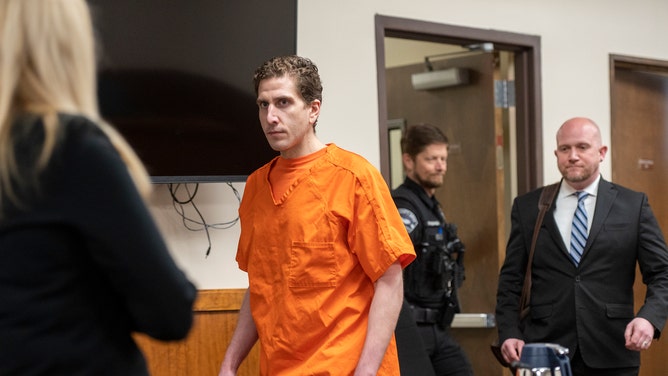We Finally Have New Information On The Evidence Against Bryan Kohberger Ahead of Possible Death Penalty Case
In 11 weeks, Bryan Kohberger will stand trial for the murders of four Idaho University roommates on Nov. 13, 2022.
Kohberger, a 30-year-old doctoral student studying criminology at Washington State University, is accused of stabbing to death Madison Mogen, Kaylee Goncalves, Xana Kernodle, and Ethan Chapin at an off-campus home on King Road in Moscow, Idaho.
Because of an ongoing gag order, few details have been revealed about the case since Kohberger's arrest in December of that year. Authorities have only confirmed the details of the arrest affidavit, revealing that police recovered a knife sheath left behind at the murder scene that contained Kohberger's DNA.
But over the past year, NBC's "Dateline" was able to gather information regarding the case through anonymous sources with knowledge of the investigation. Titled "The Terrible Night on King Road," NBC aired a special on Friday detailing its reporting for the first time.
The episode upholds the popular online theory that the killer never intended to target all four victims, but instead, it was a plan that went awry.
According to Dateline's understanding of the events, the killer entered the open around 4 a.m. with the intention of killing only Madison Mogen. But, to his surprise, Mogen was not alone. Kaylee Goncalves, who had recently moved out and returned for a visit, was sleeping in Mogen's bed with her.
On the floor below, Xana Kernodle was scrolling through Instagram and heard a struggle above. When she ran up to the next floor, the killer chased her back down to her bedroom. It is believed the killer dropped the sheath while chasing Kernodle.
On that floor, the killer found Kernodle's boyfriend, Ethan Chapin, passed out in bed. According to the report, the killer struck Chapin with a knife just once, hitting an artery.
An eventually exhausted killer came across a fifth roommate, Dylan Mortensen, whom he passed by on his way out the door. Criminologists who spoke to "Dateline" believe the intruder didn't have the stamina to attack a fifth victim, especially one who didn't engage with him physically.
Hours later, police found Mogen, Goncalves, Kernodle, and Chapin dead in "pools of blood." Mortensen described the intruder as a man with "bushy eyebrows" but could not identify Kohberger during four interviews with police.
Timeline of Nov. 13, 2022:
- 4 a.m.: Suspect arrives at house
- Between 4 and 4:17: time of murders
- 4:19: Roommate calls three victims, no one answers
- 4:22 to 4:24: Surviving roommates text each other from inside house
- 4:27: Roommate calls victims again; no one answers
- 4:32: Roommate texts Goncalves 'Pls answer'
- 10:23: Surviving roommate texts victims; no one answers
- 11:39: Roommate calls her father
- 12 p.m.: 911 call placed from roommate's phone

MOSCOW, IDAHO - MAY 22: Bryan Kohberger enters the courtroom for his arraignment hearing in Latah County District Court, May 22, 2023 in Moscow, Idaho. Kohberger is accused of killing four University of Idaho students in November 2022. (Photo by Zach Wilkinson-Pool/Getty Images)
"Dateline" could not answer why Kohberger, whose defense maintains his innocence, would have targeted Mogen. By all accounts, the two were strangers who hung out in opposite circles.
However, author Howard Blum, who wrote a book about the murders in 2024, proposed that while strangers, Kohberger may have been well aware of Mogen's existence –- to the point of an obsession.
For years, Kohberger has followed a rigid vegan diet after he was bullied in high school for his weight. The Mad Greek is the only restaurant in the area known for serving vegan dishes. In fact, a former employee told People Magazine in 2023 that she saw Kohberger there "at least twice" ordering vegan pizza.
The relevance: Mogen was a waitress at the Mad Greek.
"Kohberger most likely first crossed paths with Mogen at the Mad Greek restaurant on Main Street in Moscow," Blum, whom Dateline interviewed, claims. "The restaurant was the only one in town to serve the sort of vegan dishes that Kohberger's relatives told me he preferred. It was also where Mogen worked as a waitress."
"Did they talk? Did he ask her out? The prosecution and the defense have agreed that there is no evidence of any interaction – either in person or on social media. But I believe that wouldn't have been necessary for Kohberger to become infatuated with 21-year-old Mogen's pretty face, long blonde hair and sparkling personality. Obsessions came easily to him. He was, after all, a recovering heroin addict."
As the theory goes, Kohberger viewed Mogan as the archetype of the exact kind of woman he could never have: beautiful, vibrant, popular, and fun.
"After this initial encounter at the Mad Greek, I suspect that Kohberger continued to follow Mogen and, at some point, obsession turned into murderous intent," Bum adds. "Then, whenever 1122 King Road hosted a party - as they often did - he may have been watching from the shadows."
For the record, it's unclear if the prosecution believes or will present any of the theories "Dateline" during the trial.

Now, to the evidence.
Amazon records show that Kohberger purchased a matching sheath (to the one at the scene with his DNA) and Ka-Bar knife (which authorities claim was used to slay all four victims) months prior to the date of the murders. After the killings, records show Kohberger "clicked to purchase" another sheath and knife on but "never finished the order."
Criminologists suggest he wanted to buy a new knife/sheath to show authorities that his were not missing or containing the DNA of the victims. Or, perhaps, Kohberger, whose browser history showed a fascination with notorious serial killer Ted Bundy, was planning something else.
Of course, the defense will almost certainly argue that ordering a knife and searching for another is not a crime. As of publication, police have not recovered the murder weapon.
Elsewhere, the jury will have to decipher the significance of the FBI cellphone tower data showing Kohberger's cellphone pinged "nearly a dozen times" to a tower that provides coverage to an area within 100 feet of the home in which the victims were murdered.
The cellphone records indicated that Kohberger was within 100 meters of the King Road house on 23 occasions. All the trips were after dark. Fox News Digital provided a summary below:
At 3:30 a.m. on Nov. 13, 2022, the night when Kernodle, Goncalves, Mogen and Chapin were killed, a white Hyundai Elantra resembling Kohberger's was seen turning onto King Road, according to security video.
Just three minutes later, the car was seen leaving King Road and turning right. Five minutes later, at 3:38 a.m., the car was back on King Road and exited at 3:40 a.m.
At 3:56 a.m., the car was again seen turning onto King Road, and left at 3:58 a.m. At 4:06 a.m., the Elantra was seen doing a U-turn and going back onto King Road. At 4:20 a.m., after Kohberger allegedly killed the four college students, the car was seen speeding away from the King Road house.
At 10:31 a.m., Kohberger's phone pinged to a tower that served the towns of Clarkston, Washington, and Lewiston, Idaho. According to the "Dateline" report, law enforcement officials believe Kohberger could have been disposing of evidence such as a knife or clothing.
Kohberger allegedly went back to the King Road area at 9:12 a.m. on Nov. 13, 2022. He was allegedly in the area for nine minutes, then went back to his apartment in Pullman, Washington.
At 10:31 a.m., Kohberger's phone pinged to a tower that served the towns of Clarkston, Washington, and Lewiston, Idaho. According to the "Dateline" report, law enforcement officials believe Kohberger could have been disposing of evidence such as a knife or clothing.

MOSCOW, ID - JANUARY 3: Police tape surrounds a home that was the site of a quadruple murder on January 3, 2023 in Moscow, Idaho. A suspect has been arrested for the murders of the four University of Idaho students. (Photo by David Ryder/Getty Images)
While the cellphone data is circumstantial, Judge Jeanine Pirro reminded OutKick during Alex Murdaugh's trial that circumstantial evidence can be enough to convict someone of murder (especially when their DNA is found at the scene).
"The circumstantial evidence must be consistent with each other," Pirro said. "It must point conclusively to guilt beyond a reasonable doubt in order to convict."
If convicted, Kohberger is facing the possibility of death by firing squad, the state of Idaho's primary method of execution.
The "Dateline" episode concluded by stating that any sentence in which Kohberger avoids the death penalty would be a win for the defense, indicating how strongly they view the evidence against him.